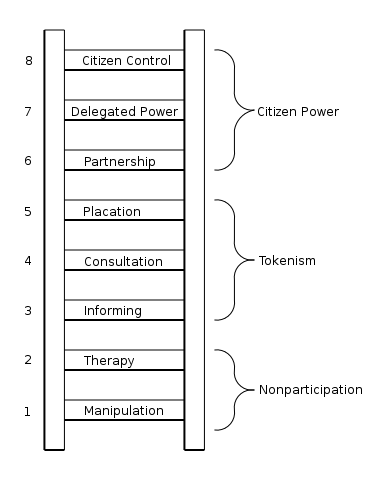There is a growing body of literature on public participation in environmental assessment and decision-making, within which several authors (e.g. Antunes et al., 2009; NRC, 2008) have proposed a set of critical issues to be considered in the setup, design and management of participatory processes.
At inception stage, government agencies should cater for (NRC, 2008): (i) clarity of purpose, (ii) a commitment to use results in decision-making, (iii) appropriateness of funding and staff, (iv) appropriate timing of participation in relation to decisions and (v) a commitment to self-assessment and learning. One of the critical decisions to be made during process setup concerns selecting the desired level of intensity and influence of public input on decisions. The options are often represented along a ‘spectrum of participation impact’, ranging from information and consultation, to involvement, collaboration and empowerment (see Figure 1).
In designing the process, close attention should be paid to the relationship between the level of participation impact and the participatory methods deployed. There are no clear-cut solutions, although certain tools and techniques fit particularly well to specific contexts, purpose and desired level of participation impact. The options for the implementation of a participatory process include a variety of methods and tools, thoroughly reviewed in several studies. Furthermore, process design should be guided by the principles of inclusiveness, collaborative problem formulation, transparency and good-faith communication (NRC, 2008).
Finally, the management of scientific inputs and multiple information sources in a participatory process is another issue of utmost importance and considerable debate. This resonates with the Post-Normal Science framework, according to which knowledge needs to be increasingly ‘democratized’ in complex decision processes, paying attention to the multiple legitimate perspectives of ‘expert’ and ‘lay’ constituencies, and considering both facts and values. As argued by Vatn (2009) participatory methods and deliberation represent rule structures that facilitate the articulation of participants’ values.
Management of information and quality assurance are then critical features of participatory processes, guided by principles of inclusiveness, socially robustness of knowledge and transparency. Illustrations of various forms of participatory and deliberative democracy in action may be found in the experiences of ‘participatory budgeting’ in Porto Alegre, Brazil, in the reform of public education systems in Chicago, United States, and, in the governance of local villages in India where one important issue that should also be analysed is how to avoid ‘participatory exclusions’ grounded on gender or caste discrimination (Agarwal, 2001). With the emergence of alternative ways of conceiving the so-called ‘progressive’ forms of democracy, the opportunities for public participation will continue to expand in increasingly decentralized, interdependent and networked democratic societies (NRC, 2008).
References
Agarwal , B. (2001) Participatory exclusions, community forestry and gender, World Development, 29 (10) 1623-1648 .
Antunes, P., Kallis, G., Videira, N., Santos, R., (2009) Participation and evaluation for sustainable river basin governance. Ecological Economics, 68, 931–939.
NRC – National Research Council of the National Academies (2008) Public Participation in Environmental Assessment and Decision Making. Panel on Public Participation in Environmental Assessment and Decision Making, Thomas Dietz and Paul C. Stern, eds. Committee on the Human Dimensions of Global Change. Division of Behavioral and Social Sciences and Education, The National Academies Press: Washington DC, USA.
Vatn, A. (2009) An institutional analysis of methods for environmental appraisal. Ecological Economics, 68, 2207–2215.
For further reading:
Aragonès, E., Sánchez-Pagés, S. (2009) A theory of participatory democracy based on the real case of Porto Alegre. European Economic Review, 53, 56-72.
Habermas, J. (1984) The Theory of Communicative Action. Beacon Press: Boston, USA.
Pateman, C. (1970) Participation and Democratic Theory. Cambridge University Press; Cambridge, UK.
Reed, M. (2008) Stakeholder participation for environmental management: A literature review, Biological Conservation, 141, 2417–2431.
Renn, O., Scheizer, P.J. (2009) Inclusive Risk Governance: Concepts and Application to Environmental Policy Making. Environmental Policy and Governance, 19, 174–185.
Rousseau, J., (1762). The Social Contract Or Principles Of Political Right. Available from http://www.constitution.org/jjr/socon.htm.
Sen, A. (1999) Democracy as a Universal Value. Journal of Democracy, 10 (3) 3-17.
Useful websites:
Initiative for the European Citizens’ Initiative [http://www.citizens-initiative.eu]
International Association for Public Participation [http://www.iap2.org]
Participatory democracy [http://democraciaparticipativa.net]
IAP2 – International Association for Public Participation, 2006. IAP2’s Public Participation Toolbox [http://www.iap2.org/]
IAP2 – International Association for Public Participation, 2007. Spectrum of Public Participation [http://www.iap2.org/]
This glossary entry is based on a contribution by Paula Antunes
EJOLT glossary editors: Hali Healy, Sylvia Lorek and Beatriz Rodríguez-Labajos




